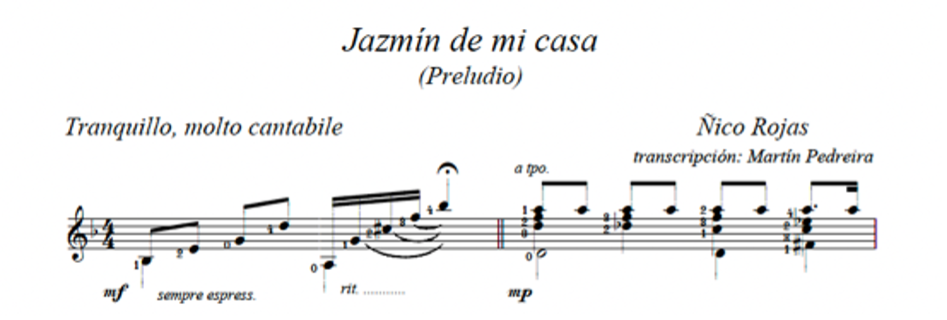Cuban Music in the Method
The last composer I would like to discuss in this blog is José Antonio (Ñico) Rojas, who was a professional hydraulic engineer. Rojas was self-taught in the guitar and never learned to write compositions in traditional notated musical form. He began to compose after becoming part of the filin’ movement alongside his contemporaries: César Portillo de la Luz and José Antonio Méndez. For many years most of Rojas’s work remained unpublished and unrecorded. Renowned music figures like Benny Moré, Chucho Valdéz, Leo Brouwer, César Portillo de la Luz, and Wynton Marsalis have praised his work.[1]
Rojas was an early member of the filin movement. The filin derives from the English word “feeling” and presents a characteristic mixture of harmonic elements of blues and jazz, with the traditional Cuban popular romantic song: canción. It was a popular type of song from the late 1940s to the early 1960s, usually performed accompanied by a guitar. In this genre there is a strong element of Debussy’s impressionism, which reached Cuba through American music.[2]
The themes of filin songs were private and poetic. Often the songs were told rather than sung, which gave singers freedom while performing them. The sensuality of the melody alternates with the rhythmical bass lines. The use of triplets generates an instability that provides the swinging flavor. The jazzy harmonies with dominant seventh chords are used to add color and a sad romantic feeling.
Jazmín de mi casa (Jasmine of the house) by Ñico Rojas presents some of the characteristic features of this type of song, in this case, instrumentally. The piece is in D minor and has two sections, A and A’ with a quick introduction. The harmony has colorful dominant chords from the beginning with a V9/13. It features a lot of secondary dominant chords, diminished seventh chords, and non-chord tones, characteristics of jazz. (See Example 1)

Example 1 Ñico Rojas, Jazmín de mi casa, m.1. Introduction
Another distinctive element of the genre is the use of triplets alternating with 16th– and 8th-notes giving the sense of freedom and instability. The top line in this piece is often static, with chromatic movement in the bass line creating tension. When the melodic line moves, it usually does it with a conjunctive descending stepwise motion in the lower register, which portrays the singer’s lament. It mimics the told melody where singers tell the story rather than sing it.
The leaps in the melodic contour feel unexpected and feature dissonant intervals. In m. 5, almost like a cry, a diminished fifth interval (tritone) descends chromatically to a repeated note. This contrast between the intense harmonic motion and the stillness of the high register portrays the inner emotions of the singer, melancholic and blue, while surrounded by the calmness of the house and its garden’s jasmine. (See Example 2)

Example 2 Ñico Rojas, Jazmín de mi casa, mm. 3-6.
In the second section, the rhythmic figures get faster with a passage with a sextuplet and a septuplet. The texture also grows with bigger chords and arpeggios. The agogic and dynamics help to build up the tension until it reaches the end, with a descending cascade of notes slowing down until the last subtle harmonics. The pianissimo’s final chords bring back the calmness of the landscape. (See Example 3)

Example 3 Ñico Rojas, Jazmín de mi casa, mm. 13-21.
Technically, this piece has fast passages, chords, arpeggios, slurs, and effects that the student can work on. However, the biggest challenge is to maintain the sense of pulse while performing all the different rhythms. It should not sound strict nor inflexible but either with excessive rubato. Although instrumental, this piece is still based on a song genre, so the singer (melody in the guitar) should have the freedom to express feelings but a steady pulse so the guitar accompanist can follow properly. Jazmín de mi casa is a great piece to work on expressiveness and finding a nice balance in the interpretation.
[1] Cubafilinrecords. “Jose Antonio (Ñico) Rojas.” https://cubafilin.com/collections/jose-antonio-nico-rojas accessed March 11, 2023.
[2] Helio Orovio, Cuban Music from a to Z, 1st English-Language Ed. (Durham: Duke University Press, 2004), 84.